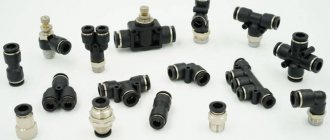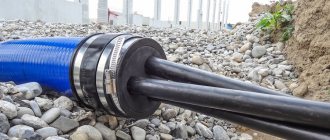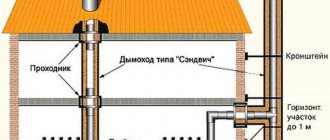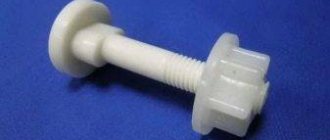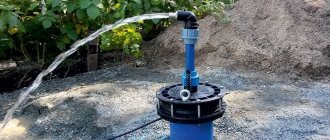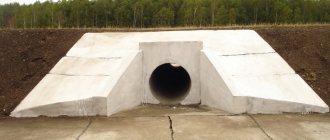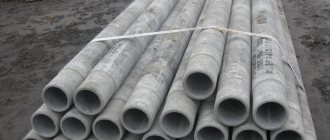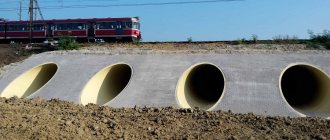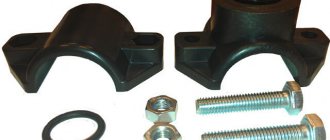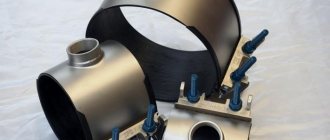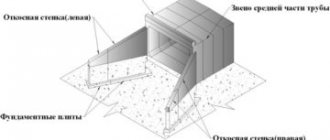Culvert heads
Sizes and prices
| Name | Volume | Weight | Length | Width | Height |
| AO-10 | 1.42 m³ | 3.540 t. | 6,000 mm. | 300 mm. | 2,500 mm. |
| AO-8 | 0.69 m³ | 2.210 t. | 5,000 mm. | 300 mm. | 2,000 mm. |
| D-10 | 0.99 m³ | 2.475 t. | 1 800 mm. | 350 mm. | 2,700 mm. |
| D-12 | 1.20 m³ | 3,000 t. | 2 400 mm. | 350 mm. | 2 400 mm. |
| D-15 | 1.60 m³ | 4,000 t. | 2 400 mm. | 400 mm. | 3 300 mm. |
| D-6 | 0.85 m³ | 2.130 t. | 1 800 mm. | 350 mm. | 1 900 mm. |
| DP-12 | 0.72 m³ | 1.800 t. | 2 400 mm. | 250 mm. | 2 200 mm. |
| DP-15 | 1.08 m³ | 2.700 t. | 2 400 mm. | 300 mm. | 2 900 mm. |
| DP-16 | 0.96 m³ | 2.400 t. | 2 400 mm. | 300 mm. | 2 900 mm. |
| DR-10 | 0.99 m³ | 2.475 t. | 1 800 mm. | 350 mm. | 2,700 mm. |
| DR-15 | 1.60 m³ | 4,000 t. | 2 400 mm. | 400 mm. | 3 300 mm. |
| DR-6 | 0.85 m³ | 0.230 t. | 1 800 mm. | 350 mm. | 1 900 mm. |
| DR-8 | 0.91 m³ | 2.476 t. | 1 800 mm. | 350 mm. | 2 200 mm. |
| OG-10 | 0.14 m³ | 0.340 t. | 1,000 mm. | 500 mm. | 1,000 mm. |
| OG-18 | 1.10 m³ | 2.750 t. | 3,000 mm. | 1 100 mm. | 1 800 mm. |
| OG-23 | 0.77 m³ | 1.925 t. | 1 500 mm. | 1 200 mm. | 2 300 mm. |
| OG-33 | 1.91 m³ | 4.775 t. | 2,000 mm. | 1 600 mm. | 3 300 mm. |
| OP-10 | 1.50 m³ | 3.750 t. | 6,000 mm. | 300 mm. | 2,000 mm. |
| OP-6 | 1.69 m³ | 4.220 t. | 6,000 mm. | 300 mm. | 2,000 mm. |
Culvert heads from
From a constructive point of view, bell-shaped, corridor, collar, as well as portal and streamlined heads are produced. Such elements are represented by input and output products, but only a correctly selected design guarantees the high-quality functioning of the system.
Bell-shaped version
The element has sloped wings, represented by a wall that is normally related to the longitudinal axis, as well as a pair of walls that have variable heights and are located at a certain angle, due to which all slopes are supported. The presence of an angle of 20-30° helps to create the most favorable conditions for the passage of water flow, therefore such products are often used in non-pressure and semi-pressure water supply systems.
Collar option
The element has a characteristic elliptical shape. Collar heads have an outermost pipe link clearly cut off relative to the slope cavity, bordered by a special collar-type belt. This special design is in high demand when arranging pipeline systems. Providing the most favorable conditions for water flow, this product option is quite difficult to manufacture.
Conical and portal options
The first type is an element represented by a hollow truncated cone. A portal-type product is a vertical retaining wall that reliably holds the slope of an embankment. In this case, the conical links are intended for single-point and multi-point pipes with an opening of 1.0, 1.25, 1.5 and 2.0 m. Special pattern blocks must be mounted under the conical link of the head. The portal walls consist of a rectangular block with a special opening that fully corresponds to the dimensions of the head opening.
Standards and product labeling
The characteristics of manufactured products are regulated by current interstate standards. Product markings are represented by one or two standard alphanumeric groups, separated by a hyphen. The first group includes type designations and nominal sizes. All manufactured products are tested for strength and crack resistance.
Delivery of culvert heads
Delivery of culvert heads is carried out by our own transport to Moscow, Moscow, Oryol, Ryazan, Kaluga and other regions of Russia! Delivery estimates can be ordered in the Delivery section.
Precautions must be taken when delivering Culvert Heads. According to GOST, heavy cargo can be transported only in a horizontal position in special vehicles. When loading/unloading, it is prohibited to move several pieces at a time. Exception: rigging work with special devices, where lifting several products at the same time is allowed.
When storing in open ground, a pad with a thickness of at least 10 cm is placed at the base of the stack; a drain for water is required.
Culvert pipe heads price in Moscow
Culvert heads price per piece. The price depends on their size, thickness, presence/absence of strengthening additives, reinforcement. In order not to overpay for the goods, it is advisable to order culvert heads directly from the manufacturer. This way you will receive certified reinforced concrete products with a laboratory report and at the best cost.
Our company can offer you the optimal balance between quality and cost.
You can request our price list and place an order in the section of the site that interests you.
Come check out the prices and make sure that cooperation with us will be beneficial for you.
Ours has been operating since October 2003.
Buy culvert heads at the concrete products factory
It is profitable to buy culvert heads without intermediaries at. New culvert heads are always available in our warehouses. We are now increasing production capacity and looking for new reliable partners.
If you are serious about cooperation, contact us at the numbers listed in the “Contacts” tab.
Culverts for highways
This article will discuss culverts, their main features, the construction of the pit and foundation, as well as the structures used for the construction of culverts.
Culvert pipes for highways are artificial structures that allow small permanent or periodic watercourses to pass under road embankments.
In some cases, such pipes can also play the role of tunnel overpasses or cattle runs.
In the process of designing a road, especially in cases where the embankment has a small height, most often there is a choice between one of two possible types of structure - a pipe or a small bridge.
A culvert pipe is the preferred option in case of minor differences in the technical and economic indicators of these structures for the following reasons:
- The culvert does not cause a disruption in the continuity of both the subgrade and the superstructure of this path;
- Culverts are less expensive to operate and repair than a small bridge;
- In the case when the backfill above the pipe has a height exceeding 2 m, the influence of temporary loads on the structure is reduced and practically disappears with an increase in this height.
Features of culverts
Depending on the material of the pipe body, the following types of pipes are distinguished:
- Reinforced concrete culverts;
- Polymer;
- Concrete;
- Metal.
In addition, reinforced concrete and other culvert pipes differ in the following parameters:
- Cross-sectional shape: rectangular, round and ovoid;
- Number of points in the section: one-, two- and multi-point;
- Work of the cross section: pressure, working along the entire length with a full cross-section, and semi-pressure, working with a full cross-section near the inlet head and incomplete - along the rest of the length of the pipe.
Reinforced concrete culverts also have the following hole diameters:
- If the length of the culvert (rarely sewer) pipe does not exceed 30 m, the diameter of the hole must be at least 1 meter;
- For a length of up to 15 m - at least 50 cm in the case of a device within a high-flow pipe;
- The installation of culverts for on-farm roads allows a hole diameter of 50 cm with a pipe length not exceeding 10 meters.
Important: the backfill above the slabs or pipe links to the lower level of the road surface must be at least 50 centimeters thick.
Reinforced concrete pipes, culverts and road bridges (medium and small) can be located on sections of roads, the profile and plan of which are accepted for roads of this category. Pipes are usually equipped in a free-flow mode, with the exception of pressure or semi-pressure mode in order to pass the calculated water flow.
In addition, it is prohibited to build culverts in the presence of ice drift or dams, and when installed on streams and rivers where there are fish spawning grounds, the construction of pipes requires permission from the fisheries inspection.
Design features of the heads
Every homeowner should have a good understanding of how a well head works and what it is needed for. This information will help you make an informed choice in favor of this or that device and not be disappointed in the purchase.
All produced standard headbands have a simple device. Their design contains:
- The cover is the main element of the device.
Almost all other parts are located on this part. The lid is made in the shape of a disk. It has an inner ring, the diameter of which is selected to match the cross-section of the casing pipe. There is a hole in the central part of the disk. It is used to secure the HDPE pipeline. Typically its diameter is 25, 32 or 40 mm.
On a note! When the well head is installed, the part of it that protrudes beyond the inner ring rests on the end of the casing pipe.
Manufacturers produce caps with different outer diameters. Standard models are used on casing pipes with a cross-sectional size of 90-160 mm. The design of each cover still contains holes for bolts and electrical cables.
One of the options for the head cover Source eco-kotly.ru
- A flange is a ring-shaped part that is equipped with holes for bolt fasteners.
This head element is put on the casing pipe. Then it is bolted to the cover. As a result, a single structure is formed, which is fixedly and hermetically fixed on the surface of the pipe.
- Carabiner for securing the cable.
It is needed for hanging submersible pumping equipment.
- The seal is in the form of a rubber ring.
This part is placed between the flange and the cover. It ensures sealing of the connection. Due to the rubber ring, the head is held tightly on the casing pipe.
- Eye bolts with a ring-shaped head.
One of these elements may be turned down. With this design, a cable is attached to it, on which the pump is suspended. Eye bolts facilitate installation work. They allow heavy pumps to be installed with a head when using a winch.
- A collet clamp that is located in the center of the device.
It is a compression fitting for permanently fixing the pipe.
Headband with central collet clamp in the form of a compression fitting Source cstor.nn2.ru
- Entry for electrical cables that prevents direct contact with the cover.
It is a pressure seal that is screwed into the headband. The result is a sealed hole. It meets all well operation requirements.
- Terminal box, which is not present on every headband.
This element is used to connect the wiring from the house to the power cable of the pump.
- Bolts for connecting the cover and flange together with a rubber sealing ring.
On a note! The water well head can be anti-vandal. With this option, the bolt heads are recessed into the lid. Therefore, a special wrench is used to unscrew and tighten them.
About the construction of culverts
Calculation of culverts during construction also includes the following nuances:
- The edge of the subgrade at the points of access to the pipe should rise relative to the design water level by at least 50 centimeters, and in the case of pipes operating in semi-pressure and semi-pressure modes - by at least 1 meter;
- The heads of the culverts should include a portal wall and two slope wings, which are buried in the soil 25 centimeters below the freezing depth and installed on a crushed stone base, the thickness of which is 10 centimeters.
Important: natural soil located below the freezing depth is replaced with a sand and gravel mixture.
In accordance with the load-bearing capacity of pipes, they are classified into three groups:
- The first group - the estimated height of backfilling with soil is 2 meters;
- The second is 4 meters;
- The third is 6 meters.
Important: depending on the conditions of a particular construction, when crossing a watercourse or other obstacle, it is permissible to use pipes that have a different design height for filling with soil.
Excavation pits for culverts
When developing foundation pits for culverts, fastening is most often not provided. The stability of the walls of such a pit cannot be ensured only in conditions of water-saturated soil with a significant influx of water - in this case, the soil is excavated, protecting it with fastenings.
In addition, fastening of the pit is provided in the case of construction of a pipe located at a short distance from the operating structures - in this case, the fastening ensures the stability of these structures.
The various characteristics of a pit depend on a number of factors:
- The development technology and the outline of the pit are designed in accordance with the design and foundation of the pipe, as well as the type and condition of the foundation soils;
- When assigning slope steepness, the depth of the pit and the characteristics of the excavated soil are taken into account;
- In the case of applying a waterproofing layer to the pipe structure or performing other work that involves people staying in the pit, the distance between the vertical wall of the pit should be at least 70 cm from the side surface of the foundation;
Important: if such work is not planned, this value can be reduced to 10 cm.
Reinforced concrete culvert pipes
In the case of concrete-free concreting of the foundation, the dimensions of the pit are taken equal to the dimensions of the foundation itself;
- In the case of developing a pit with slopes, the distance from the bottom of the slope to the foundation should not be less than 30 cm.
In any case, the dimensions of the pit must be linked to the capabilities of the excavation equipment used. In addition, during the construction of a pit, it is necessary to prevent its filling with ground and surface water, for which purpose soil rollers are poured along the perimeter of the pit.
In the case of constructing a pipe in place of a permanent watercourse, dams are constructed or the channel is diverted to the side using ditches.
Removing water penetrating into the pit can be done in two ways:
- In the lower part of the pit, an outlet is arranged into a ditch to drain water, which is most often used in the case of the construction of slope pipes.
- Provide mechanized drainage. To do this, the lower part of the pit is equipped with a fenced pit, the water from which is pumped out using a pump.
Important: the pit must be located outside the foundation contour to ensure drainage during all foundation work, including backfilling of sinuses.
As the pit is deepened, the pit fences are also lowered.
Foundation
When constructing culverts, installation of a foundation from prefabricated elements for a culvert is carried out as follows:
- The foundation blocks of the heads are laid, reaching the base of the foundation of the pipe itself.
- The sinuses of the foundation heads are filled to an equal level.
- The cavities of the head foundations are backfilled with local soil.
- Places where foundations meet at different depths are covered with a mixture of sand and gravel or sand and crushed stone.
- The mixture is compacted layer by layer and filled with cement solution.
- Simultaneous laying of the head foundations and sectional installation of the pipe foundation are carried out.
Important: installation is carried out sequentially from the place where the outlet head of the culvert is located, moving in the direction of the inlet head. For multi-row masonry, the seams are bandaged.
The process of arranging a monolithic foundation includes the following operations:
Useful: the foundation has simple outlines, so ordinary inventory panels can be used to make formwork.
In the case of a prefabricated monolithic foundation, a cushion or base is prepared, where formwork is then installed in the intersection joints.
The gaps between the formwork located at the joints and the prefabricated elements are filled with a mixture of concrete. In regions with weak soil, pile foundations are also used.
After the construction of the foundation and filling of the sinuses are completed, the installation of prefabricated heads and the pipe body itself begins.
To install prefabricated pipes, self-propelled cranes are used, determining their lifting capacity in accordance with the mass of the head blocks, pipe body and foundation, taking into account the possible reach of the crane boom. The installation procedure depends on the terrain conditions and what design is chosen for the head section of the pipe.
Briefly about the main thing
A well cap is a cap or plug for the casing of an underground water source. The installation of the device is carried out to prevent debris from entering the source, reducing heat loss, more convenient installation of additional equipment, and preventing theft of the pump.
Manufacturers make headbands from metal and polymer. The design of the devices usually includes a bottom flange, tightening bolts, a top cover, an O-ring, a hole for the cable and HDPE pipes.
The installation of the head on the casing pipe is carried out at 90°. First, a flange and a rubber sealing ring are put on it. Then an electric pump, previously connected to the HDPE pipe and supply wires, is lowered into the source. These elements are output through the upper part of the headband. Finally, it is connected to the flange by tightening the bolts.
Protection against water freezing is provided by additional insulation of the head. To do this, build a thermally insulated box over the well or install a heating cable. If there is a caisson, its walls and hatch are insulated.
Ratings 0
Culvert structures
As already mentioned, culvert-type hydraulic structures in the form of an artificial structure for civil or industrial purposes are called culverts.
Such structures are usually built directly on a natural or artificial reservoir, or at a short distance from it. Most often, culverts are made in the form of a culvert located above the highway.
In addition, reinforced concrete culverts can be used to adjust or change the channels of small rivers.
The construction of such structures today is most often carried out using metal corrugated structures (MCS), used for the following objects:
- Culvert pipes in railway and highway beds as an alternative to pipes made of concrete rings;
- Culvert structures that strengthen and change river beds;
- An alternative to single-span bridges in the form of arched structures;
- Multi-span bridges with a span of up to 18 m are an alternative to concrete or metal bridges.
Prefabricated Corrugated Metal Structures
Metal corrugated prefabricated structures (CMCS) have a lower cost in the construction of culverts compared to reinforced concrete, and also have a number of advantages over other types of structures:
- Adaptability , which allows, thanks to different cross-sections of pipes, to select the most suitable option for the conditions of a particular construction;
- Low weight makes it easier to transport SMGK sheets, and their packaging in pallets significantly reduces the space occupied by the sheets;
- Ease of installation , allowing pipe construction using SMGK sheets without special skills and qualifications;
- High strength and design flexibility provided when used in conjunction with backfill soil. In addition, this provides greater seismic resistance than concrete structures;
- Long service life, reaching 80-100 years, as shown by many years of practice in the use of such structures;
- Low cost , allowing to reduce costs when using SMGK by 30-50% compared to the use of other materials;
- Possibility of constructing SMGC culverts in any climate.
Gabion culvert structures
The use of gabion structures is also widely popular in the construction of drainage and culvert pipes and structures, as well as in the construction of stabilizing and retaining structures, retaining walls and local treatment road and bridge structures.
In its finished form, such a structure is a culvert of the required diameter reinforced with gabions.
Gabions have become so widespread due to a number of positive characteristics:
- Flexibility, strength and resistance to stress;
- Resistance to the negative effects of moisture and precipitation;
- Drainage ability , which does not require additional costs for installing a return filter and drainage system;
- Possibility of use with other types of structures;
- Simplicity of installation and operation of the structure;
- Low temporary construction and operating costs;
- Environmental safety and aesthetic appearance;
- Reliability and durability of operation.
That's all I wanted to tell you about what culverts for highways are. It should be additionally noted that the construction of these structures (as well as the installation of sewer pipes or the installation of metal-plastic pipes with your own hands) requires special care and compliance with the requirements and standards of construction and safety, since their violation can cause not only damage or destruction of the pipe itself, but also the road, under which this pipe runs.
Types of culverts, methods and areas of use
The area of application of culverts has become road construction. With the help of such pipe products, a unique alternative to the bridge structure is created. The dimensions of the tunnels for which a culvert is used are sometimes quite large.
With the help of these products, artificial structures are built that are capable of passing small volumes of constant or periodically occurring water flows under road embankments. Sometimes such pipes serve as overpasses or are used for moving livestock.
When designing highways, when the embankment has a small height, one of two types of artificial structures is chosen: the construction of a small bridge or the laying of pipes.
For a number of reasons, in some cases installing a culvert under the road becomes the best option:
- This design solution does not lead to damage to the integrity of the roadbed and the upper part of the road structure.
- Maintenance and operation of culvert structures will cost less than repairing a bridge.
- If the height of the backfill above the pipes exceeds the two-meter mark, the influence of temporary loads decreases, and with increasing layer height it can practically disappear.
Definition and necessity of using a head
A well head is a device for shaping the top of the casing pipe, which is placed in a mine opening when an autonomous water supply is created. This element is made in the form of a plug. It is placed at the end of the casing pipe. Its functions are the same as those of the superstructure above the well.
To clearly understand why a well head is needed, let’s consider the main points:
- Protection of the water source, since after installation, various debris, dust, dirt, and precipitation are prevented from entering the well. In winter, the so-called plug also prevents the formation of ice in the upper part of the borehole channel as a result of freezing of surface water.
- Sealing and reducing heat loss in winter. The cover fits tightly to the casing, which reduces the outflow of heat from the water source. Often, an additional heating cable is installed in the channel to completely prevent water from freezing. Due to the sealed connection between the plug and the casing, less electrical energy is required for heating.
The so-called plug is hermetically connected to the casing. Source homeli.ru
- Securely hold additional equipment thanks to its robust design. The cover allows you to attach a cable with a carabiner, to which the submersible electric pump is hooked. The plug is designed in such a way that it is possible to conveniently place the electrical cable to power the pump unit.
- Anti-theft protection for electric pump. After all, homeowners purchase most models for decent money. So, Grundfos SP9 costs about 2000 USD. e. The well cover is designed in such a way that it will be difficult for an inexperienced person to remove it and remove expensive equipment from the water source.
- Convenient connection of the pipeline from the pumping unit with the water supply system, which is laid to the house. The pipe is removed from the submersible equipment through a special hole in the well cover. It is located in its central part. After the pipeline is brought out through the hole in the head, it is cut in place and connected via a compression fitting to the water main.
Head connected to the water main using compression fittings Source eurobion.info
- Artificially maintaining the level in a water source. This is especially true for wells with shallow depths, in which, due to the low position of the water surface, a rarefaction area appears. It prevents the level from increasing.
There are traditional and improved models of well covers. Conventional devices do not allow you to quickly remove pumping equipment. To dismantle it, you must first unscrew the bolts to remove the cover from the casing. It is also necessary to disconnect the pump from the electrical cable and disconnect it from the pipeline. Because of this, the time required for maintenance and repair of submersible pumping equipment increases.
The design of new models includes a removable central part. Therefore, there is no need to waste time unscrewing bolts. In addition, a modern well pipe head has a terminal box. It allows you to quickly disconnect and connect the electrical cable.
Inverted headband with terminal box Source ecobt.ru
Types of Culverts
Depending on the materials of manufacture, these pipe products are:
- reinforced concrete;
- concrete;
- polymer;
- metal.
In addition, culverts differ in a number of parameters:
- cross-sectional shape - it can be round, rectangular and oval;
- number of points in the section – one, two or more;
- features of the functioning of the cross section.
As for the last parameter, they can be:
- pressure pipes that operate with a full cross-section along their entire length;
- semi-pressure products, operating with a full cross-section only at the inlet head;
- non-pressure products operating along the entire length with an incomplete cross-section.
In turn, reinforced concrete products are distinguished by the size of the hole diameter:
- when the length of the product does not exceed 30 meters, its size must be at least 100 centimeters;
- for a length of up to 15 meters – from 50 centimeters;
- the installation of a culvert for an on-farm road allows the use of products with a 50-centimeter hole diameter, provided that their length is no more than 10 meters (read: “Which culvert to lay under the road - types, features, advantages of materials”).
As a rule, this type of pipe products is installed in a free-flow mode, and the other two options are used if necessary to pass a certain (calculated) volume of water.
The law prohibits the laying of culverts in the presence of dams or ice drift on the ground. As for laying on rivers where fish spawn, this will require a permit issued by the fisheries inspection.
Features of head installation
The homeowner must have complete information about the water source equipment in order to control its installation, which is performed by hired craftsmen. In particular, he must know what type of device the well head has, and how to install it correctly is recommended by experts.
If it is necessary to install a well cover together with an electric pump, it is better to contact a specialized company. After all, specialists have all the necessary tools and consumables. They will carry out the work in compliance with the rules of regulatory documents and guarantee the uninterrupted operation of the equipment.
Typically, installation begins with measuring the required length of electrical cable, pressure pipe and cable. These elements are then prepared taking into account the measurements taken.
Before installing the well head, prepare an electrical cable, cable and HDPE pipe of the required length Source eco-kotly.ru
Installation of culvert systems
When making calculations for laying culvert systems, a number of nuances must be taken into account:
- The edge of the subgrade at the points of approach to the structure should be located at least 50 centimeters above the flow level. If the pipes operate in pressure and semi-pressure modes, then this parameter increases to 1 meter.
- The heads must have some elements of culverts, namely 2 slope wings and a portal wall. During the construction process, they need to be buried in the soil 25 centimeters lower than the freezing level of the soil. Installation is carried out on a 10-centimeter base made of crushed stone. In this case, the natural soil below the freezing mark is replaced with a mixture consisting of sand and gravel.
Depending on the load-bearing capacity, products are divided into 3 groups:
- first - the height of filling them with soil is 2 meters;
- in the second this parameter is –4 meters;
- in the third -6 meters.
But according to the conditions of individual projects, when constructing a passage through a water stream or other type of obstacle, it is allowed to use pipes for which a different design height of backfilling with earth is used.
Construction of pits
Usually, fastenings are not used when preparing pits for laying such products. In this case, the stability of the walls cannot be ensured only if the soil is water-saturated and the volume of water inflow in it is significant. Solving the problem will require excavating the soil and protecting it with a support structure.
In addition, fastening of the pit is provided when laying culverts is carried out at a close distance from the buildings in use.
The characteristics of the pit are affected by the following nuances:
- When designing work, the technology for developing an object and its outline depends on the structural features of the pipe, as well as on the characteristics of the foundation soil.
- When calculating the steepness of slopes, the depth of the pit and the condition of the existing soils are taken into account.
- If it is necessary to apply a layer of waterproofing to the pipes or perform other types of work during which workers will be in the pit, the vertically located wall of the object must be located at a distance of at least 70 centimeters from the side surface of the foundation. When such events are not planned, this parameter can be reduced to 10 centimeters.
- With the flameless concreting method, the parameters of the pit must correspond to the parameters of the foundation.
- When constructing a pit that has slopes, the distance from their base to the foundation cannot be less than 30 centimeters.
The dimensions of the pit should be compared with the capabilities of special excavation equipment. When constructing pits, it is necessary to prevent them from filling with water—surface or groundwater—to do this, small earthen ramparts are placed along their perimeter.
If the pipe is constructed in places with a constant water flow, dams are built, or the river bed is diverted to the side by laying ditches.
You can remove water from the pit using one of the following methods:
- In its lower part, an outlet is constructed into a ditch - this method is used when laying slope pipes.
- A mechanical drainage system is installed. To do this, a fenced pit is installed in the lower part, and water is pumped out of it with a pump.
Frost protection
To effectively operate a water source, it is not enough to know how to properly install the well head. It is also necessary to ensure that the water is protected from freezing. A so-called plastic plug is best suited for this. However, a polymer device is not 100% correct for this task when the water surface in a deep source is located next to the head.
To completely prevent freezing, additional insulation is performed. One option is to thermally insulate the walls, hatch and other elements of the caisson well, if it was previously created.
On a note! The caisson is installed when the top of the casing is below the ground surface. The well must be thermally insulated if a pump, automation, filter system, relay, or hydraulic tank are installed in it.
The caisson must be insulated when installing additional equipment Source global-bur.ru
Another insulation option is to create a heat-insulating box. This is a simple way to prevent water in a well from freezing. It is implemented by building a wooden box over the water source, which is insulated, for example, with basalt wool. Cheaper heat insulators are also used - polystyrene foam, rags and even paper.
Freezing of the water at the source can also be prevented by using a heating cable. It is placed in a pressure pipeline located in the well. For such protection to work effectively, the inlet opening is well sealed.
On a note! The best option for connecting a heating electric cable is to use a box with terminal blocks on the headband. Therefore, when choosing this option for protection against water freezing, it is recommended to purchase a well plug in this particular design.
Foundation arrangement
The construction of a foundation for laying pipes using prefabricated elements is carried out in a certain order:
- The foundation blocks of the heads are laid, bringing them to the bottom of the base of the pipe.
- The sinuses of the foundations of the heads are filled up until an equal level is obtained.
- The cavities of the head foundation are backfilled using local soil.
- In places where foundations meet different laying depths, a mixture of sand with gravel or crushed stone is poured.
- The backfill is first compacted layer by layer and then cement mortar is poured.
- The creation of foundations for the heads and the sectional laying of the pipe foundation are done simultaneously.
Work begins from the location of the outlet pipe head, moving towards the inlet head.
- The monolithic foundation is built in stages:
- Formwork is made and installed.
- Prepare the concrete mixture and pour it.
- Take care of the laid concrete layer.
- The formwork is dismantled.
- Sinuses fall asleep.
When arranging foundations of a prefabricated monolithic type, first a cushion or base is prepared and formwork is placed in the intersection joints. The existing empty spaces are filled with concrete mixture. In areas with weak soils, a pile foundation is built.
After completing the arrangement of the base and filling the sinuses, they begin laying the prefabricated pipe heads and body.
Self-propelled cranes are needed to lay prefabricated structures such as steel culverts. The sequence and order of installation depend on the terrain and the type of structure chosen for the head section.
Hydraulic facilities made from culvert products
This type of structure is erected either directly on a reservoir or at a slight distance from it. Most often you can see culvert structures made from pipe products above the road surface.
Concrete culvert pipes are often used to change the direction of a small river.
The construction of hydraulic structures is currently usually carried out using metal corrugated structures (abbreviated MGK).
They are used in certain cases:
- When creating culverts designed to strengthen and change the course of small rivers.
- When constructing an alternative to bridge crossings that have a single span in the shape of an arch.
- When laying pipes in highways or railways as a replacement for concrete rings.
- For the construction of multi-span bridges in which the gap between spans reaches 18 meters, as an alternative to bridge crossings made of metal or concrete.
Features of selecting a well head
Before you put the head on the well, you need to select it correctly. To eliminate errors, the selection is made based on the device labeling. It is a combination of numbers and letters.
Headbands are marked with letters and numbers Source eco-kotly.ru
Each symbol used in the marking has its own meaning:
- OS – abbreviated designation for the well head;
- A – anti-vandal design;
- P – plastic device (the absence of a letter means that the product is made of metal);
- B - the letter symbol is used when marking Gilex products, which do not need to be completely disconnected from the casing pipe for dismantling or installing pumping equipment along with the cable, cable and pressure pipe (Jilex devices are equipped with a removable central part);
- 90-110 – outer diameter of well casing pipes;
- 25, 32 or 40 – the cross-sectional size of the collet clamp for fixing a plastic pipe of the same outer diameter.
On a note! Some manufacturers use their own combinations of symbols to mark heads. In this case, it is recommended to consult sellers in specialized stores or managers of the company where the well cap is purchased and installed.
MGK teams
Prefabricated corrugated metal structures (abbreviated SMGC), used in the construction of culverts, have a lower cost compared to reinforced concrete products.
They have a number of advantages:
- Due to the presence of a variety of cross sections, you can easily select products for specific construction work.
- Their low weight makes it possible to easily transport SMGK sheets, and the ability to pack them in pallets reduces the space they fill.
- Simple installation allows you to lay pipes from SMGK sheets without special qualifications or special skills.
- The flexibility and strength of the resulting structure is ensured when used together with backfill soil. Thanks to this, the erected structure has greater seismic resistance compared to structures made of concrete.
- Long service life, which can reach 80-100 years, confirmed by many years of experience in using structures.
- The low price allows you to reduce the amount of costs due to the use of SMGK by approximately 30-50%, when compared with the use of other materials.
- It is possible to carry out work on laying pipes from SMGK in various climatic conditions.
Corrugated metal culvert pipes, according to experts, are the most resistant to loads. This advantage is explained by the fact that iron as a material copes better with external influences compared to concrete and plastic.
A significant drawback that prevents the widespread distribution of pipes made of this material is that they are highly susceptible to corrosion processes, and therefore are afraid of moisture.
Gabion structures
When constructing stabilizing and retaining, water drainage and culvert objects, retaining walls and local treatment structures of the road and bridge type, gabion products have become widely in demand.
When already constructed, such an object looks like a culvert of a certain diameter, reinforced with gabions, which have gained popularity due to the following positive qualities:
- strength;
- flexibility and resistance to stress;
- resistance to the negative effects of precipitation and humid air;
- having the ability to drain, which does not require additional costs for installing a special design and a return filter;
- simple construction work;
- simplicity, reliability and durability of operation;
- aesthetic appearance and environmental safety;
- low time and financial costs for construction;
- Possibility of operation with structures of different types.
Carrying out work using culvert pipe products must be carried out especially carefully, in compliance with building codes and requirements, since their violation leads to the destruction of both the pipe and the road surface under which it is laid.
Video description
The design features and subtleties of installation of the Gilex headband are described in the following video:
When choosing a plug head, take into account the advice of experienced specialists. Professionals recommend choosing a plastic model for a shallow well, in which a low-power pump will not be located very far from the surface of the earth. If a heavy electric pump is immersed to a considerable depth to pump a significant volume of water, it is better to purchase a metal cover for the well.
In addition, it is recommended to use the terminal box carefully when operating high-power pumping equipment. The reason for this advice is that this method does not ensure 100% reliability of the connection of wires with a large electric current. This causes the terminal strips to overheat. As a result, the electrical cable and the plastic well cover melt.
On a note! There is always high humidity in the caisson. Despite the reliable insulation of the terminal box, corrosion of the contacts still occurs. For this reason, sooner or later they may overheat or a short circuit in the electrical circuit may occur.
